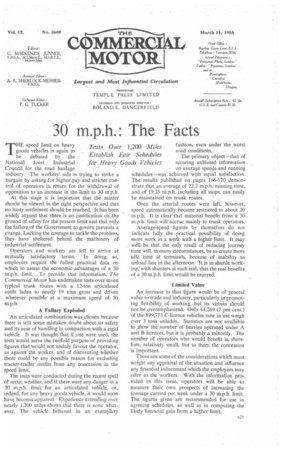30 m.p.h.: The Facts
Page 27

If you've noticed an error in this article please click here to report it so we can fix it.
THE speed limit on heavy goods vehicles is again to be debated by the National Joint Industrial Council for the road haulage industry. The workers' side is trying to strike a bargain by asking for higher pay and stricter control of operators in return for the withdrawal of opposition to an increase in the limit to 30 m.p.h.
At this stage it is important that the matter should be viewed in the right perspective and that no hasty settlement should be reached. It has been widely argued that there is no justification on the ground of safety for the present limit and that only the failure of the Government to govern prevents a change. Lacking the courage to tackle the problem, they have sheltered behind the machinery of industrial settlement.
Operators and workers are left to arrive at mutually satisfactory terms. In doing so, employers require the fullest practical data on which to assess the economic advantages of a 30 m.p.h. limit. To provide that information, The Commercial Motor has undertaken tests over seven typical trunk routes with a 12-ton articulated outfit laden to nearly 19 tons gross and driven wherever possible at a maximum speed of 30 m.p.h.
Tests Over
A Fallacy Exploded An articulated combination was chosen because there is still some mistaken doubt about its safety and its ease of handling in comparison with a rigid vehicle. It was thought that if one were used, the tests would serve the twofold purpose of providing figures that would not unduly favour the operator, as against the worker, and of discovering whether there could be any possible reason for excluding tractor-trailer outfits from any concession in the speed limit.
The tests were conducted during the recent spell of arctic weather, and if there were any danger in a 30 m.p.h. limit for an articulated vehicle, or, indeed, for any heavy goods vehicle, it would soon have become apparent. Experience extending over nearly 1,200 miles shows that there is none whatever. The vehicle behaved in an exemplary fashion, even under the worst road conditions.
The primary object—that of securing unbiased information on average speeds and running schedules—was achieved with equal satisfaction. The results published on pages 166-170 demonstrate that an average of 22.2 m.p.h. running time, and of 19.35 m.p.h. including all stops, can easily be maintained on trunk routes.
Once the arterial routes were left, however, speed automatically became restricted to about 20 m.p.h. It is clear that material benefit from a 10 m.p.h. limit will accrue mainly to trunk operators.
Average-speed figures by themselves do not indicate fully the practical possibility of doing more work in a week with a higher limit. It may well be that the only result of reducing journey time will, in many circumstances, be to create more idle time at terminals, because of inability to unload late in the afternoon. It is in shuttle working, with shunters at each end, that the real benefits of a 30 m.p.h. limit would be enjoyed.
Limited Value An increase to that figure would be of general value to trade and industry, particularly in promoting flexibility of working, but its virtues should not be overemphasized. Only 61,269 (7 per cent.) of the 899,773 C-licence vehicles now in use weigh over 3 tons unladen. Statistics are not available to show the number of heavies operated under A and 13 licences, but it is probably a minority. The number of operators who would benefit is, therefore, relatively small, but to them the concession is important.
These are some of the considerations which must weight any appraisal of the situation and influence any financial inducement which the employers may offer to the workers. With the information provided in this issue, operators will be able to measure their own prospects of increasing the tonnage carried per week under a 30 m.p.h. limit. The figures given are recommended for use in agreeing schedules, as well as in computing the likely financial gain from a higher limit.




























































































